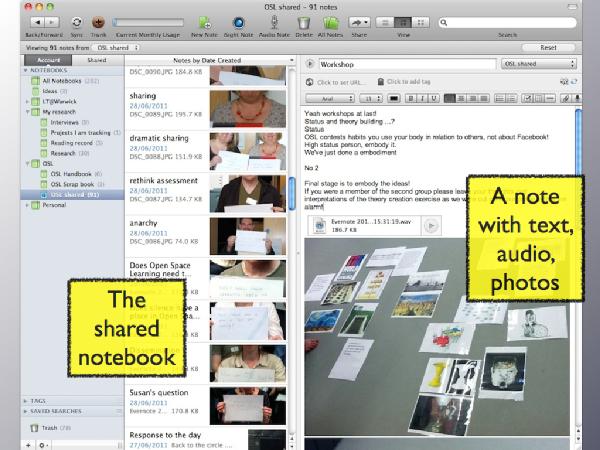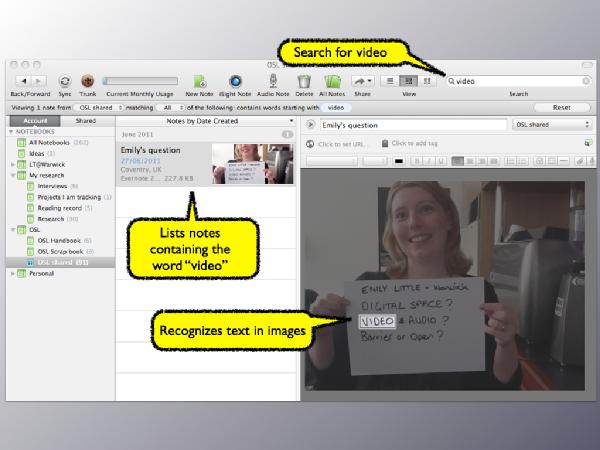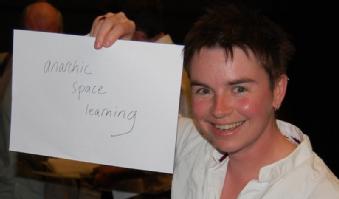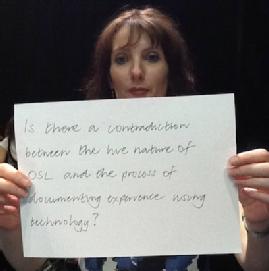Live Archiving
Towards the end of the Open-space Learning project (mid 2011), technologies finally started to become widely available that would allow us to explore an aspect of OSL that might prove to be of great significance - what Jonny Heron has termed "live archiving". For example, during OSL sessions, students can now easily take photos, record snippets of audio and video, add text, and have their "recordings" synchronised seamlessly and automatically (via wifi) into online notebooks. They can then revisit these multimedia notes, displayed on a timeline, or categorised by keywords. The notes can be reorganised (into notebooks or with keywords). Extended, perhaps even into a full essay. They can be re-used in other documents (an essay, a blog etc). They can be shared selectively with others. Or they can simply be read and reflected upon.
There are various ways in which this can be achieved. We have started to use a "cloud synced" online notebook service called Evernote. We have a set of iPod Touch 4 devices (about £180 each), and a set of larger iPad 2 devices. Evernote also runs on Android, Windows and Blackberry phones, as well as Mac OSX and Windows based computers. The basic service (adequate for most uses except when collaboratively editing notebooks) is free. It has some major advantages - it works just as well when not in wifi range, synchronises notes quickly and efficiently, has intuitive and fast user interfaces, and superb search tools (more on that below). The dekstop/laptop based version allows for notes to be edited and used more extensively - so for example, one can take an image and insert it into a note using the camera built into an iPod, and then return later to the note on the desktop version and edit it into a full document. The value of this for the action-reflection cycle is obvious. It is also possible to take digital photos on an ordinary non-wifi camera, and then on the desktop version to drag them into a notebook, creating a new note for each image.
Here's what the desktop version looks like. Notice that the note on the right of the screen has been created on an iPad, with text, audio and photos, describing an OSL activity. The notebook displayed in the middle column of the page was created at the OSL conference. It contains a rich set of notes created by a group of people.
During the conference, we used a technique that may prove to be particularly useful. At two points during the day, delegates were asked to write their responses on A4 sheets of paper. These were photographed and inserted into notes (on one occasion using iPads, and on another using a Digital SLR). This created a sharable and searchable collection of notes. So for example, searching for "video" finds a note containing a photo with the word "video" handwritten on an A4 sheet. Yes - text recognition is built in, and works very well (including with joined up handwriting).
Here is an image illustrating it working:
The whole process is relatively un-obtrusive and simple. It can provide participants with a record of the event to use later. It might also have the effect of focussing participants upon reflecting upon what they are doing as they do it - making a note of this sort is an act of consciously selecting, framing and describing.
However, there are some important issues to consider...
|
"Anarchic space learning" Cath Lambert, Department of Sociology |
"Is there a contradiction between the live nature of OSL and the process of documenting experience using technology?" Ruth Leary, Cultural Policy Studies |
As Cath Lambert (joyously) notes, the "anarchic", transgressive and playful element of OSL is a significant part of its potential. There may be, as Ruth Leary observes, a "contradiction" between the process of recording and the embodied sense of "being there" - the liveness of OSL.
We need to carefully consider how this new technology integrates with the learning ecology of an OSL session and the wider ecology in which that occurs. Issues such as privacy, intellectual and moral rights, re-use of images, need to be thought-through and designed into activities. The expectation for a "take-home" artifact that many now assume needs to be carefully balanced against the sense that everything is being observed and recorded (and hence we can't take risks). Careful thought needs to be given over to using these techniques to enhance the usefulness of an OSL experience (especially to promote reflection and further action).




